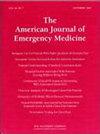全州医院系统中患者种族与急诊科使用人身限制措施之间的关系
IF 2.7
3区 医学
Q1 EMERGENCY MEDICINE
引用次数: 0
摘要
方法纳入2019年1月1日至2022年6月30日期间在大西洋中部全州医院系统急诊室的八个农村、郊区和城市急诊室就诊的成人患者。不包括那些已经被限制人身自由、从拘留中心转运过来或在提供服务之前离开的患者。多变量逻辑回归测量了物理约束的使用与患者种族的关系,并对年龄、性别、体重、身高、到达方式、暴力行为史、合并症、ESI 急性程度、无家可归和地点进行了调整。研究对象中 48.7% 为非西班牙裔白人,43.7% 为非西班牙裔黑人。与白人患者相比,黑人患者受到约束的调整后几率更高(OR 1.26,95 % CI 1.15-1.37)。与使用物理约束相关的其他关键变量包括:ESI 等级 1 vs 3+ (OR 13.15,95 % CI 11.49-15.04)、执法人员到达(8.39,95 % CI 7.47-9.43)和急救人员到达(5.36,95 % CI 4.93-5.04)。83 在受到约束的患者中,与白人患者相比,黑人患者在到达急诊室后的第一个小时内受到约束的风险更高(调整后的风险比为 1.14,95 % CI 为 1.01-1.30)。未来的工作应评估这些发现是否是由患者特征或临床医生决策的差异引起的,以便为减少这种差异的干预措施提供最佳信息。本文章由计算机程序翻译,如有差异,请以英文原文为准。
Association between patient race and emergency department physical restraint use in a statewide hospital system
Objective
To measure the association between patient race and physical restraint use in the ED.
Methods
Adult patients presenting to eight rural, suburban, and urban EDs in a mid-Atlantic statewide hospital system ED between January 1, 2019 and June 30, 2022 were included. Those arriving already restrained, transported from detention centers, or who left before services were provided were excluded. Multivariable logistic regression measured the association of physical restraint use with patient race, adjusting for age, sex, weight, height, mode of arrival, history of violent behavior, comorbidities, ESI acuity level, homelessness, and site.
Results
Of 896,527 patient encounters included in the analysis, 3459 (0.39 %) had a physical restraint order. The study population was 48.7 % non-Hispanic White and 43.7 % non-Hispanic Black. Black patients had higher adjusted odds of being restrained relative to White patients (OR 1.26, 95 % CI 1.15–1.37). Other key variables associated with physical restraint use were an ESI level of 1 vs 3+ (OR 13.15, 95 % CI 11.49–15.04), arrival by law enforcement (8.39, 95 % CI 7.47–9.43), and arrival by EMS (5.36, 95 % CI 4.93–5.83 Among those who were restrained, the hazard of restraint was higher among Black compared to White patients in the first hour after ED arrival (adjusted hazard ratio 1.14, 95 % CI 1.01–1.30).
Conclusion
Black patients were more likely to be physically restrained compared to White patients, though the magnitude of this association was small compared to that of other clinical risk factors. Future work should evaluate if these findings are driven by differences in patient characteristics or clinician decision-making to best inform interventions to reduce this disparity.
求助全文
通过发布文献求助,成功后即可免费获取论文全文。
去求助
来源期刊
CiteScore
6.00
自引率
5.60%
发文量
730
审稿时长
42 days
期刊介绍:
A distinctive blend of practicality and scholarliness makes the American Journal of Emergency Medicine a key source for information on emergency medical care. Covering all activities concerned with emergency medicine, it is the journal to turn to for information to help increase the ability to understand, recognize and treat emergency conditions. Issues contain clinical articles, case reports, review articles, editorials, international notes, book reviews and more.

 求助内容:
求助内容: 应助结果提醒方式:
应助结果提醒方式:


